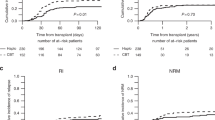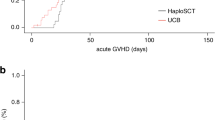Summary:
Acute lymphocytic leukemia (ALL) is a common indication for hematopoietic stem cell transplantation (HSCT) in children. Use of unrelated cord blood (UCB) has become increasingly popular as a stem cell source, given the rapid availability and decreased GVHD potential. Publications describing outcomes of children with leukemia who underwent UCB transplants have compared them to those having received unrelated donor marrow transplants. Results are similar. We compared our outcomes using UCB vs allogeneic-related hematopoietic stem cells in pediatric ALL patients since 1992. A total of 49 patients were analyzed. All patients were either in CR1 with high-risk features (n=21) or in CR2 (n=28) with initial remission less than 36 months. Patients received myeloablation with fractionated total body irradiation, cyclophosphamide, and etoposide and GVHD prophylaxis with cyclosporine and methotrexate. Antithymocyte globulin was added for UCB recipients to address the HLA differences. In all, 23 patients underwent allogeneic -related HSCT and 26 underwent UCB transplantation. Other than increased time to engraftment for UCB recipients, results are equivalent. The 3-year overall survival is 64% and 3-year event-free survival is 60% for both groups. Rates of GVHD and transplant-related mortality are also equivalent. UCB is a reasonable option for children with ALL who are referred for HSCT.
This is a preview of subscription content, access via your institution
Access options
Subscribe to this journal
Receive 12 print issues and online access
$259.00 per year
only $21.58 per issue
Buy this article
- Purchase on Springer Link
- Instant access to full article PDF
Prices may be subject to local taxes which are calculated during checkout

Similar content being viewed by others
References
Chessells JM, Leiper AD, Richards SM . A second course of treatment for childhood acute lymphoblastic leukaemia: long-term follow-up is needed to assess results. Br J Haematol 1994; 86: 48–54.
Henze G, Fengler R, Hartmann R et al. BFM group treatment results in relapsed childhood acute lymphoblastic leukemia. Haematol Blood Transfus 1990; 33: 619–626.
Sanders JE, Flournoy N, Thomas ED et al. Marrow transplant experience in children with acute lymphoblastic leukemia: an analysis of factors associated with survival, relapse, and graft-versus-host disease. Med Pediatr Oncol 1985; 13: 165–172.
Brochstein JA, Kernan NA, Groshen S et al. Allogeneic bone marrow transplantation after hyperfractionated total-body irradiation and cyclophosphamide in children with acute leukemia. N Engl J Med 1987; 317: 1618–1624.
Uderzo C, Valsecchi MG, Bacigalupo A et al. Treatment of childhood acute lymphoblastic leukemia in second remission with allogeneic bone marrow transplantation and chemotherapy: ten-year experience of the Italian Bone Marrow Transplantation Group and the Italian Pediatric Hematology Oncology Association. J Clin Oncol 1995; 13: 352–358.
Locatelli F, Rocha V, Chastang C et al. Factors associated with outcome after cord blood transplantation in children with acute leukemia. Eurocord–Cord Blood Transplant Group. Blood 1999; 93: 3662–3671.
Rocha V, Cornish J, Sievers EL et al. Comparison of outcomes of unrelated bone marrow and umbilical cord blood transplants in children with acute leukemia. Blood 2001; 97: 2962–2971.
Gluckman E, Rocha V, Boyer-Chammard A et al. Outcome of cord-blood transplantation from related and unrelated donors. Eurocord Transplant Group and the European Blood and Marrow Transplantation Group. N Engl J Med 1997; 337: 373–381.
Sullivan KM, Shulman HM, Storb R et al. Chronic graft-versus-host disease in 52 patients: adverse natural course and successful treatment with combination immunosuppression. Blood 1981; 57: 267–276.
Przepiorka D, Weisdorf D, Martin P et al. 1994 consensus conference on acute GVHD grading. Bone Marrow Transplant 1995; 15: 825–828.
Ugozzoli L, Yam P, Petz LD et al. Amplification by the polymerase chain reaction of hypervariable regions of the human genome for evaluation of chimerism after bone marrow transplantation. Blood 1991; 77: 1607–1615.
Champlin R, Ho W, Gajewski J et al. Selective depletion of CD8+ T lymphocytes for prevention of graft-versus-host disease after allogeneic bone marrow transplantation. Blood 1990; 76: 418–423.
Bordigoni P, Vernant JP, Souillet G et al. Allogeneic bone marrow transplantation for children with acute lymphoblastic leukemia in first remission: a cooperative study of the Groupe d’Etude de la Greffe de Moelle Osseuse. J Clin Oncol 1989; 7: 747–753.
Stockschlader M, Hegewisch-Becker S, Kruger W et al. Bone marrow transplantation for Philadelphia-chromosome-positive acute lymphoblastic leukemia. Bone Marrow Transplant 1995; 16: 663–667.
Snyder DS, Chao NJ, Amylon MD et al. Fractionated total body irradiation and high-dose etoposide as a preparatory regimen for bone marrow transplantation for 99 patients with acute leukemia in first complete remission. Blood 1993; 82: 2920–2928.
Woolfrey AE, Anasetti C, Storer B et al. Factors associated with outcome after unrelated marrow transplantation for treatment of acute lymphoblastic leukemia in children. Blood 2002; 99: 2002–2008.
Weisdorf DJ, Woods WG, Nesbit Jr ME et al. Allogeneic bone marrow transplantation for acute lymphoblastic leukaemia: risk factors and clinical outcome. Br J Haematol 1994; 86: 62–69.
Wheeler KA, Richards SM, Bailey CC et al. Bone marrow transplantation vs chemotherapy in the treatment of very high-risk childhood acute lymphoblastic leukemia in first remission: results from Medical Research Council UKALL X and XI. Blood 2000; 96: 2412–2418.
Rocha V, Wagner Jr JE, Sobocinski KA et al. Graft-versus-host disease in children who have received a cord-blood or bone marrow transplant from an HLA-identical sibling. Eurocord and International Bone Marrow Transplant Registry Working Committee on Alternative Donor and Stem Cell Sources. N Engl J Med 2000; 342: 1846–1854.
Martin PJ, Akatsuka Y, Hahne M et al. Involvement of donor T-cell cytotoxic effector mechanisms in preventing allogeneic marrow graft rejection. Blood 1998; 92: 2177–2181.
Rubinstein P, Carrier C, Scaradavou A et al. Outcomes among 562 recipients of placental-blood transplants from unrelated donors. N Engl J Med 1998; 339: 1565–1577.
Dalle J, Duval M, Moghrabi A et al. Results of an unrelated transplant search strategy using partially HLA-mismatched cord blood as an immediate alternative to HLA-matched bone marrow. Bone Marrow Transplant 2004; 33: 605–611.
Gluckman E, Rocha V, Arcese W et al. Factors associated with outcomes of unrelated cord blood transplants: guidelines for donor choice. Exp Hematol 2004; 32: 397–407.
Ringden O, Labopin M, Gorin N et al. Treatment with granulocyte colony-stimulating factor after allogeneic bone marrow transplantation for acute leukemia increase the risk of graft-versus-host disease and death: a study from the Acute Leukemia Working Party of the European Group for Blood and Marrow Transplantation. J Clin Oncol 2004; 22: 416–423.
Author information
Authors and Affiliations
Corresponding author
Rights and permissions
About this article
Cite this article
Jacobsohn, D., Hewlett, B., Ranalli, M. et al. Outcomes of unrelated cord blood transplants and allogeneic-related hematopoietic stem cell transplants in children with high-risk acute lymphocytic leukemia. Bone Marrow Transplant 34, 901–907 (2004). https://doi.org/10.1038/sj.bmt.1704681
Received:
Accepted:
Published:
Issue Date:
DOI: https://doi.org/10.1038/sj.bmt.1704681
Keywords
This article is cited by
-
TBI, etoposide, and cyclophosphamide conditioning for intermediate-risk relapsed childhood acute lymphoblastic leukemia
International Journal of Hematology (2024)
-
Comparative analysis of unrelated cord blood transplantation and HLA-matched sibling hematopoietic stem cell transplantation in children with high-risk or advanced acute leukemia
Annals of Hematology (2015)
-
Future of cord blood for oncology uses
Bone Marrow Transplantation (2009)
-
Outcome following unrelated cord blood transplant in 136 patients with malignant and non-malignant diseases: a report from the Australian and New Zealand children's haematology and oncology group
Bone Marrow Transplantation (2009)
-
Acute graft-versus-host disease in children
Bone Marrow Transplantation (2008)



